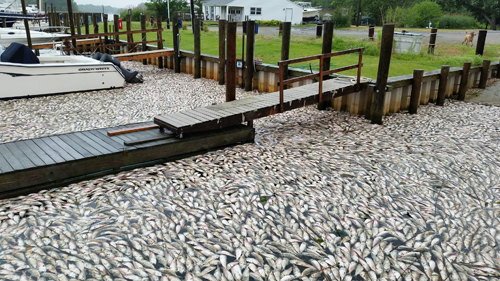Top Stories 2015: Fish die-offs clog the Peconic Estuary

North Fork beaches had some less-than-ideal visitors this summer: thousands of dead bunker fish.
Beginning in May and lasting throughout most of June, dead bunker fish were seen floating in local waters and piling onto the shorelines. It would prove to be one of the largest fish kills in recent memory.
The cause of the huge die-off? A lack of oxygen in the water, caused by an algal bloom fed by an increase of nitrogen, experts said.
Environmentalists and bilogists believe the increased nitorogen levels were most likely the result of ineffective waste treatment systems — specifically, outdated cesspools and septic tanks — and fertilizers, which entered the water through rain runoff.
This rise in nitrogen levels led to an increase in algae blooms, otherwise known as red or brown tide. In order to continue to grow, the algae need oxygen, causing the oxygen levels to drop to zero and limiting the amount available in the water for the fish — causing them to die and wash ashore. The fish carcasses then feed more bacteria that make the water even more oxygen-deprived.
Initially, elected officials with the Town of Riverhead hoped a high tide would take the dead menhaden (the scientific name for bunker) back into the Estuary. But the tides didn’t help as much as town staff had hoped, and the Town Board ended up using volunteers and town employees to remove the dead fish bodies.
The fish kills came only a few weeks after dozens of turtles in the Peconic Estuary in mid-May, caused by shellfish containing saxitoxin, a biotoxin that causes paralyzing shellfish poisoning. Experts assembled by Suffolk County lawmakers blamed the turtle-die off on the same high nitrogen levels.








